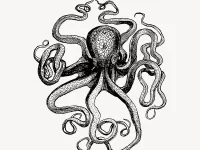In the depths of the ocean, one true master of disguise steals the spotlight. The mimic octopus, scientifically known as Thaumoctopus mimicus, is a species of octopus native to the Indo-Malayan Archipelago and Great Barrier Reef. A sand dwelling cephalopod, the mimic octopus is found at depths ranging from 2 to 12 meters near river mouths where the seabed is rich with crustaceans and worms on which to feed. Despite its alarming appearance, this soft-bodied and non-venomous creature is an enticing target for various predators. Consequently, the mimic octopus has developed an array of defensive adaptations. Among these, one astonishing talent has left scientists in awe of nature’s genius: its extraordinary gift for mimicry.
Like many of its relatives, the mimic octopus expertly employs the art of camouflage to seamlessly blend into its surroundings, whether it be the sandy seafloor or rocky substrate. However, what truly sets the mimic octopus apart, as the name suggests, is its ability to mimic the appearance and behaviors of other organisms — a phenomenon known as mimicry.
“Watch in amazement as the mimic octopus gracefully undulates across the ocean floor, extending all eight legs backward to take on the shape, motion, and speed of a fish.”
Watch in amazement as the mimic octopus gracefully undulates across the ocean floor, extending all eight legs backward to take on the shape, motion, and speed of a fish. The octopus will even flatten its head and position its eyes prominently, just like the banded sole, a common flat-headed fish found in the same region. The mimic octopus has also been observed impersonating banded sea snakes and lionfish, depending on which predators are nearby. These three toxic animals all share the octopus’s light and dark coloring and striped pattern, making it an effective mimic. Furthermore, scientists have observed behaviors suggesting that the mimic octopus might be capable of mimicking other marine organisms, such as giant crabs, seahorses, sand anemones, and jellyfish. The mimic octopus’s preference for imitating predator species is better known by scientists as “Batesian mimicry,” a phenomenon in which a harmless organism imitates dangerous ones to evade predation. Predation is the primary driving force influencing the development of such defensive mechanisms. The better the octopus blends into its environment or mimics more dangerous species, the lower the likelihood of it being detected by predators or potential prey. In the case of mimic octopus, mimicry may be linked to its tendency to forage in broad daylight, where it is exposed and vulnerable to predation. At night, the octopus retreats to its burrow for safety. Ironically, the mimic octopus has its own copycat. The harlequin jawfish, a species of jawfish native to the same region, has been observed by researchers hiding in the shadows of the mimic octopus, blending in to avoid detection. While mimicry is a common strategy in nature, this octopus is the first known species capable of imitating multiple organisms.
Cephalopods, particularly octopuses, possess the fascinating ability to alter their body patterns to match changes in their visual background, a technique termed “crypsis” by scientists, or more commonly known as “camouflage.” Octopuses have a unique skin anatomy composed of pigmented chromatophore organs, reflecting iridophores, and light scattering leucophores, enabling the octopus to instantaneously generate a wide range of patterns based on their environment. The octopus will change the spatial arrangement of chromatophores in their skin by contracting or relaxing these cells in response to visual cues. While scientists have been studying this inherent adaptation for centuries, the mimic octopus’ exceptional ability to morph into the appearance of other species remains a recent and evolving subject of study.
“A fascinating illusion which repels predators with promises of death, the mimic octopus’ appearance is not always as it seems.”
A fascinating illusion which repels predators with promises of death, the mimic octopus’s appearance is not always as it seems. Challenging our understanding of the boundaries of mimicry and offering a glimpse into the intricacies of underwater life, the mimic octopus stands as a testament to the incredible diversity and adaptability of life below the waves.






